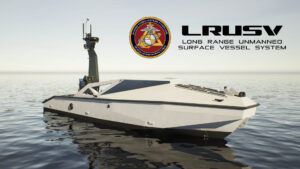The Commandant of the Marine Corps last week said the Long Range Unmanned Surface Vessel (LRUSV) the service is developing will primarily act as an intelligence, surveillance and reconnaissance (ISR) platform and the service is looking into other unmanned assets to aid logistics.
“What does it allow us to do that we can’t do right now? One is range across the surface of the water. The second, we’re going to use it primarily not as a kinetic platform, but as an unmanned vessel that can launch unmanned collection systems. This is – now you’re really doubling the reach of where you can collect, where you can inform yourself about what’s happened in front of you,” Gen. David Berger said during a virtual Defense One
event on Sept. 15.

Berger emphasized the LRUSV can also primarily be used with the electromagnetic spectrum, allowing the service to deny adversaries the ability to collect data on them and push that screening function out further away from Marines.
“So, why don’t we want to put a screen way out as far out as we can. So, the long range unmanned surface vessel, primarily for us, we’re looking at it as an ISR platform on the surface of the water that allows us to stretch out to see what’s in front of us at much greater depth, and then launch unmanned platforms in the air or on the surface or subsurface, even farther,” Berger said.
He also noted if those missions were being performed by humans currently, it would involve manned vessels and aerial platforms “limited by range and the fatigue level, the endurance level of a human being.”
In contrast, the unmanned and autonomous platform “allows us to generate a whole lot of tempo and keep a shield, keep a screen out in front of us much more persistently.”
Berger said the prototype LRUSV is currently in the Norfolk, Va. area for testing before it is sent to Hawaii.
Last year, the Marine Corps issued a Request For Information (RFI) on the capability to build multiple small USV (sUSV) launched and recovered from the LRUSV. The service is aiming for the system to be available for integration testing by the second quarter of fiscal year 2024.
The notice said the “sUSV purpose is to support LRUSV with extended reconnaissance reach and deliver kinetic and non-kinetic effects,” like providing offensive and defensive effects to protect the LRUSV, a scout ability for the LRUSV, and sea vessel intercept capability.
The RFI also noted the USV would have a “Fires Mission,” this sUSV would seek to help protect, noting the Marine Corps is looking at LUSV to have an offensive weapons capability as well.

Moreover, in early 2021, Metal Shark announced it was selected by the service to develop and implement the LRUSV system. The company said the LRUSV system will include “a network of unmanned vessels traveling autonomously for extended ranges and transporting loitering munitions to address targets at sea and on land.”
At the time, the company said the LRUSVs will be fully autonomous, optionally manned and carry multiple payloads.
Berger also said the Marine Corps and Navy are “pressing forward fast” on autonomy in the air, ground, on the surface of the water and subsurface, partly to protect human service members, but they also so the systems can help cover more ground and have a better operational tempo.
“You can cover a lot more territory with unmanned systems, teamed with manned systems. And you can also keep a tempo going that you can’t do with just human beings. So this year, for example, we’re going to buy MQ-9s – it’s not a new platform, but it allows us to collect forward, way forward, feed that back through a system that tells the whole Joint Force what’s in front of us, because we’re the stand-in force forward,” Berger said.
Separately, the commandant said while surface and subsurface autonomous vehicles allow the service to collect information on an adversary, they can also conduct tactical and operational logistics and sustain them autonomously.
“Because if you have the data, you know where the units are, it’s tracking, it’s going to know where certain things are needed at a certain point in time and geography in the future. Don’t need a human to do that. So the fuel, the munitions can be moved to them to meet them, they’re at the right place and time, all autonomously…we need to get a lot more comfortable with that way of thinking,” Berger said.
He noted unmanned and autonomous vehicles will also help with mobility, specifically medevac.
Berger said the future vision “is not M*A*S*H of watching television,” but he envisions emergency medevac helicopters or land vehicles operating without a human pilot/driver except a corpsman/medic attending to a patient.
“There’s good reasons for using unmanned systems from everything from medical to resupply of ordnance, fuel, water, if we have to move that stuff around and move people around, we’re going to use a lot more unmanned, less manned.”